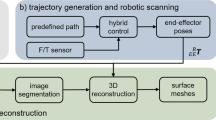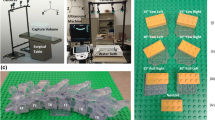Abstract
Purpose
Ultrasound is prevalent in image-guided therapy as a safe, inexpensive, and widely available imaging modality. However, extensive training in interpreting ultrasound images is essential for successful procedures. An open-source ultrasound image simulator was developed to facilitate the training of ultrasound-guided spinal intervention procedures, thereby eliminating the need for an ultrasound machine from the phantom-based training environment.
Methods
Anatomical structures and surgical tools are converted to surface meshes for data compression. Anatomical data are converted from segmented volumetric images, while the geometry of surgical tools is available as a surface mesh. The pose of the objects are either constants or coming from a pose-tracking device. Intersection points between the surface models and the ultrasound scan lines are determined with a binary space partitioning tree. The scan lines are divided into segments and filled with gray values determined by an intensity calculation accounting for material properties, reflection, and attenuation parameters defined in a configuration file. The scan lines are finally converted to a regular brightness-mode ultrasound image.
Results
The simulator was tested in a tracked ultrasound imaging system, with a mock transducer tracked with an Ascension trakSTAR electromagnetic tracker, on a spine phantom. A mesh model of the spine was created from CT data. The simulated ultrasound images were generated at a speed of 50 frames per second, and a resolution of \(564 \times 597\) pixels, with 256 scan lines per frame, on a PC with a 3.4 GHz processor. A human subject trial was conducted to compare the learning performance of novice trainees, with real and simulated ultrasound, in the localization of facet joints of a spine phantom. With 22 participants split into two equal groups, and each participant localizing 6 facet joints, there was no statistical difference in the performance of the two groups, indicating that simulated ultrasound could indeed replace the real ultrasound in phantom-based ultrasonography training for spinal interventions.
Conclusions
The ultrasound simulator was implemented and integrated into the open-source Public Library for Ultrasound (PLUS) toolkit.








Similar content being viewed by others
References
Gill S, Abolmaesumi P, Fichtinger G, Boisvert J, Pichora D, Borshneck D et al (2010) Biomechanically constrained groupwise ultrasound to CT registration of the lumbar spine. Med Image Anal 16(3):662–674
Gjerald SU, Brekken R, Hergum T, D’hooge J (2012) Real-time ultrasound simulation using the GPU. IEEE Trans Ultrason Ferroelectr Freq Control 59(5):885–892
Goksel O, Salcudean SE (2009) B-Mode ultrasound image simulation in deformable 3-D medium. IEEE Trans Med Imaging 28(11):1657–1669
Hedrick WR, Hykes DL, Starchman DE (2005) Ultrasound physics and instrumentation. Mosby, St. Louis
Hostettler A, Forest C, Forgione A, Soler L, Marescaux J (2005) Real-time ultrasonography simulator based on 3D CT-scan images. Stud Health Technol Inform 111:191–193
Jensen JA (1996) FIELD: a program for simulating ultrasound systems, pp 351–353
Jensen J (2004) Simulation of advanced ultrasound systems using Field II, vol 1. pp 636–639
Karamalis A (2009) GPU ultrasound simulation and volume reconstruction. Master’s thesis, Technischen Universität München
Karamalis A, Wein W, Navab N (2010) Fast ultrasound image simulation using the Westervelt equation. In: Medical image computing and computer-assisted intervention-MICCAI 2010. Springer, Berlin, pp 243–250
Kutter O, Shams R, Navab N (2009) Visualization and GPU-accelerated simulation of medical ultrasound from CT images. Comput Methods Programs Biomed 94(3):250–266
Lasso A, Heffter T, Pinter C, Ungi T, Fichtinger G (2012) Implementation of the PLUS open-source toolkit for translational research of ultrasound-guided intervention systems. In: Medical image computing and computer-assisted intervention (MICCAI) workshop—Systems and architectures for computer assisted interventions, Nice, France, The MIDAS Journal, pp 1–12, 10/2012
Lasso A, Heffter T, Pinter C, Rankin A, Ungi T, Fichtinger G (in review) PLUS: open-source toolkit for ultrasound-guided intervention systems. IEEE Trans Med Imaging
Magee D, Zhu Y, Ratnalingam R, Gardner P, Kessel D (2007) An augmented reality simulator for ultrasound guided needle placement training. Med Biol Eng Comput 45(10):957–967
Moult E, Ungi T, Welch M, Lu J, McGraw RC, Fichtinger G (2013) Ultrasound-guided facet joint injection training using Perk Tutor. Int J Comput Assist Radiol Surg. doi:10.1007/s11548-012-0811-5
Pieper S, Lorensen W, Schroeder W, Kikinis R (2006, 04) The NA-MIC Kit: ITK, VTK, pipelines, grids and 3D Slicer as an open platform for the medical image computing community, pp 698–701
Schroeder W, Martin K (2004, 01) The visualization Toolkit
Skehan D (2011) Virtual training system for diagnostic ultrasound. Master’s thesis, Worcester Polytechnic Institute, The United States of America
Tokuda J, Fischer G, Papademetris X, Yaniv Z, Ibanez L, Cheng P et al (2009) OpenIGTLink: an open network protocol for image-guided therapy environment. Int J Med Robotics Comput Assist Surg 5(4):423–434
Ungi T, Sargent D, Moult E, Lasso A, Pinter C, McGraw R et al (2012) Perk Tutor: an open-source training platform for ultrasound-guided needle insertions. IEEE Trans Biomed Eng 59(12):3475–3481
Vidal FP, John NW, Healey AE, Gould DA (2008) Simulation of ultrasound guided needle puncture using patient specific data with 3D textures and volume haptics. Comput Animat Virtual Worlds 19(2):111–127
Wein W, Khamene A, Clevert D-A, Kutter O, Navab N (2007) Simulation and fully automatic multimodal registration of medical ultrasound. In: Medical image computing and computer-assisted intervention—MICCAI 2007. Springer, Berlin, pp 136–143
Zhu M, Salcudean S (2010) Real time ultrasound needle image simulation using multi-dimensional interpolation. In: Jiang, T, Navab, N, Pluim J, Viergever, M (eds) Medical image computing and computer-assisted intervention “ MICCAI 2010”, vol 6362. Springer, Berlin, pp 429–436
Acknowledgments
This work was supported through the Applied Cancer Research Unit program of Cancer Care Ontario with funds provided by the Ontario Ministry of Health and Long-Term Care. Gabor Fichtinger was funded as a Cancer Ontario Research Chair. Tamas Ungi was supported as a Queen’s University—Ontario Ministry of Research and Innovation Postdoctoral Fellow. Laura Bartha was supported by the Human Mobility CREATE program of The Natural Sciences and Engineering Research Council of Canada. Conflict of interest None.
Author information
Authors and Affiliations
Corresponding author
Rights and permissions
About this article
Cite this article
Bartha, L., Lasso, A., Pinter, C. et al. Open-source surface mesh-based ultrasound-guided spinal intervention simulator. Int J CARS 8, 1043–1051 (2013). https://doi.org/10.1007/s11548-013-0901-z
Received:
Accepted:
Published:
Issue Date:
DOI: https://doi.org/10.1007/s11548-013-0901-z




